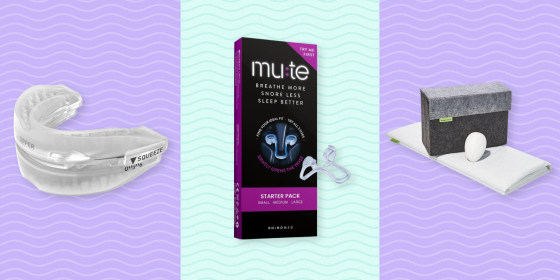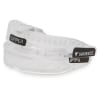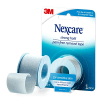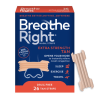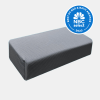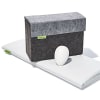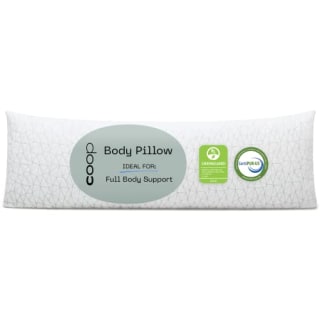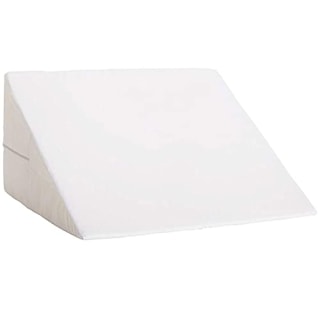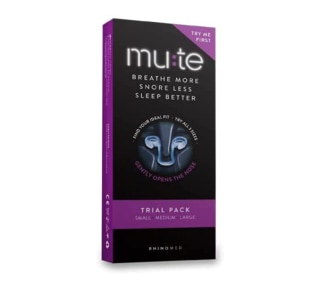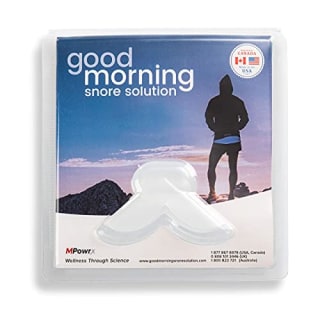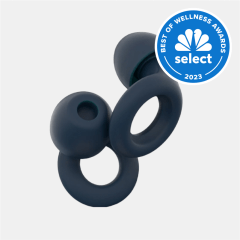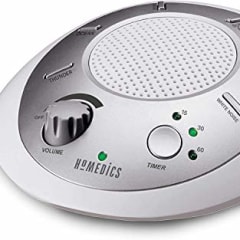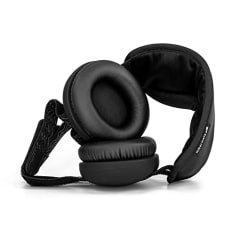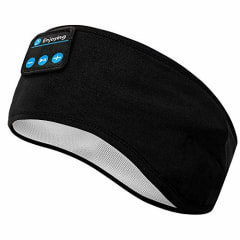Any way you look at it, snoring is disruptive — it can lead to a restless slumber for snorers and anyone who shares a bedroom with them. Luckily, there are products that can help reduce snoring, like wedge pillows, mouthpieces and nasal strips. But are they effective? Maybe. Experts say there are no guarantees that anti-snoring devices will work for you, but they’re worth a try, so long as you consult your doctor beforehand.
I talked to doctors about what snoring is, who's prone to it and what you can do to reduce how much you snore. Experts also shared different types of over-the-counter anti-snoring devices to consider, whether you’re using them yourself or buying them for the snorer in your life.
SKIP AHEAD What is snoring? | Products that address sleep position | Products that address the nasal pathway | Products that address the upper airway | Products to help if your bed partner snores | Snoring v.s. sleep apnea | Why trust NBC Select?
What is snoring?
Snoring is the vibration of the soft tissues in the upper airway, says Dr. Andrew Varga, a neuroscientist and physician at the Mount Sinai Integrative Sleep Center. When you sleep, your muscles relax since you’re laying down instead of sitting upright. This change in body position causes gravity to narrow your airways, says Dr. Noah Siegel, the director of sleep medicine and sleep surgery at Massachusetts Eye and Ear at Harvard Medical School. As air then moves through the nose and down the throat when you inhale, it generates vibration of the soft tissues in your upper airway. That vibration is the sound we associate with snoring, says Dr. Paul Chung, a physician and an instructor of neurology and sleep medicine at Northwestern University’s Feinberg School of Medicine.
Anything that further narrows the nasal pathway or the upper airway worsens snoring or makes you more likely to snore, says Chung. For example, your nasal pathway tends to narrow when you’re congested, and factors like obesity, older age, alcohol consumption and tobacco use can cause the upper airway to narrow, he says.
Snoring can be a sign of a bigger issue like sleep apnea, but there are also many cases where it’s not necessarily worrisome, says Sigel. That’s why it’s so important to talk to your doctor about snoring, especially if you notice it having a negative impact on your sleep quality.
Want more from NBC Select? Sign up for our newsletter, The Selection, and shop smarter.
The best anti-snoring devices of 2025
I talked to experts about different types of over-the-counter anti-snoring devices you may want to try and how each one works. Using their guidance, I rounded up a handful of products that fall into three main categories: devices that address sleep position, the nasal pathway and the upper airway.
Remember, there’s one caveat when it comes to all anti-snoring devices — they might work. There are no guarantees, and everyone’s body responds differently to each product. Experts recommend approaching snoring aids with an open mind and accepting that it will likely take a lot of trial-and-error to find something that works for you. Also, always talk to your doctor before trying an anti-snoring device.
Anti-snoring devices that address sleep position
Adjusting your sleeping position is one of the fastest, easiest ways to potentially reduce snoring, experts say. They unanimously agree that snorers should prioritize side sleeping and avoid back sleeping, which tends to make you snore more. That’s because when you’re supine, gravity pulls the soft tissues around your airway downward and toward the back of your throat, making the area narrower, says Chung. Sleeping on your side helps keep the airway as open as possible.
To make side sleeping more comfortable, you can use specific pillows designed to keep your spine straight and support your head, neck and shoulders while resting on your right or left. But despite their best efforts, some people can’t get comfortable while sleeping on their side. If you’re exclusively a back sleeper, a wedge pillow can help. It elevates your head so you’re not laying completely flat, reducing how much the soft tissues around your airway are being pulled downward, says Varga. Some brands also make devices that go inside your pillowcase and inflate to elevate your head when their sensors detect snoring sounds in real time, says Varga.
Finally, if you’re looking for a DIY solution to train yourself to sleep on your side, Varga recommends filling a long sock with tennis balls and sewing it to the back of an old shirt. If you start rolling over onto your back while sleeping, the balls will make it uncomfortable, causing you to wake up and readjust yourself on your side.
The best pillows for snorers
Here are a few pillows and related accessories for snorers that align with experts’ guidance. I chose highly rated items, plus products recommended by NBC Select staff.
Pillow Cube Side Cube
- Aligns head, neck and spine
- Breathable and cooling
- Springy yet supportive feel
- Requires a special pillow case
The Pillow Cube is a rectangular pillow specifically designed for side sleepers. You place the bottom of the pillow against your shoulder, and when you lay your head on it, the pillow fills the gap between your head and mattress. This helps keep your spine straight and aligned throughout the night, according to the brand. The pillow is made from firm foam to support your head’s weight, has a breathable cover and comes with a removable, machine-washable pillowcase. It measures 24 inches long, 12 inches wide and five inches high.
Coop Home Goods The Original Body Adjustable Pillow
- Adjustable fill material
- Removable, washable cover
- Full body support
- Nothing to note at this time
Body pillows are a great option for snorers looking to make side sleeping more comfortable. You drape your body over the long pillow and hug your arms around it, helping you stay on your side overnight instead of rolling over onto your back.
NBC Select reporter Harry Rabinowitz recommends Coop's adjustable body pillow because you can remove its memory foam and microfiber filling to find a loft that matches your preferences. The body pillow’s outer cover is removable and machine-washable, and it measures 54 inches long and 20 inches wide.
DMI Bed Wedge Pillow
- Dual-sided
- Removable, washable cover
- Liquid repellant coating
- Nothing to note at this time
Experts recommend looking for wedge pillows that are between 10 and 12 inches high, which elevate your head at about a 30 to 45 degree angle while you’re laying on your back. This one fits the bill at 12 inches high. Its foam core is dual-sided: one side is flat and has firm support, while the other side has an egg-crate texture that increases airflow to help keep you cool, according to the brand. The pillow’s microfiber, machine-washable cover is treated with a coating that repels liquids, protecting it from spills and moisture. It’s 24 inches long and 24 inches wide.
Smart Nora
- Works with standard pillows
- Customizable settings
- FSA/HSA eligible
- Nothing to note at this time
If you love your current pillow but want the benefit of elevating your head to reduce snoring, Smart Nora may be the ideal solution. It comes with three parts: an inflatable pillow insert, an air pump base and a microphone sensor. You place the insert inside your pillowcase, which is connected to the air pump base. The microphone sensor that sits on your side table listens for snoring sounds, and when they’re detected, it tells the air pump to inflate the pillow insert to elevate your head. Then, when it no longer detects snoring sounds, the base deflates the insert to lower your head. You can adjust how sensitive the microphone is to snoring sounds, as well as how much the pillow insert moves throughout the night. The Smart Nora is FSA- and HSA-eligible.
Anti-snoring devices that address the nasal pathway
If you have allergies, sinus issues or congestion, try to treat that first, says Chung. Your doctor may be able to prescribe nasal spray or recommend an over-the-counter medication. There are also a few products that can help open the nasal pathway, which I listed below.
Nasal strips
Nasal strips are flexible stickers that you apply right above the flare of your nostrils. They lift the sides of the nose up, which gently pulls your nostrils open and expands the size of the nasal pathway. This gives air more space to flow through as you breathe.
Breathe Right Nasal Strips Extra Strength
- Non-irritating adhesive
- Comfortable to wear
- Can relieve congestion
- May unstick over time
- Single-use
I always keep a pack of these nasal strips at home because I have seasonal allergies. I wear them when I’m congested to reduce the chance that I start snoring and immediately feel how much they open up my nose when I apply them. The nasal strips come in a pack of 26 and their adhesive has never irritated my sensitive skin. I find that they usually stay in place overnight, but Chung says the one downfall of any nasal strips is that they can unstick while you’re sleeping, especially if you don’t let skin care products dry before applying them. These nasal strips are tan, but you can also purchase clear ones.
Nasal dilators
Nasal dilators work similarly to nasal strips, but they hold the nostrils open from the inside of the nose rather than the outside. Whether you use nasal strips or nasal dilators is a personal preference — if you’ve never used either product before, experts say it may be a good idea to try both and see what works for you.
Mute by Rhinomed Nasal Dilator Starter Pack
- Multiple sizes available
- Customizable fit
- Reusable up to 10 times
- Nothing to note at this time
Nasal dilators come in different sizes, so if you’re new to using them, it’s beneficial to buy a pack with small, medium and large options. You can try each size, the one that's most comfortable and buy just that size the next time you place an order.
Mute's nasal dilators are made from a transparent, flexible, medical-grade material. They have a hook whose sides sit inside the nose, while the base rests outside the nose and on top of the nostrils. There are loops on either size of the hook, and you can adjust the size of the loops (narrower or wider) to further customize their fit. You can reuse each nasal dilator up to 10 times, according to the brand.
Anti-snoring devices that address the upper airway
There are three main anti-snoring devices that address the upper airway: two are dental devices, both of which work to widen and expand the upper airway, and one is mouth tape, which prevents you from mouth-breathing.
Mandibular advancement devices
Mandibular advancement devices (MADs), also commonly called snoring mouthguards, gently pull your lower jaw forward, giving you somewhat of an underbite, says Varga. Since your tongue is attached to your lower jaw, the device helps move the tongue muscle forward toward the front of your face. “This creates more room in the back of the upper airway and puts a little bit of tension on some of the soft tissue, making it less prone to vibrating and therefore less able to make that snoring sound,” says Varga.
Over-the-counter snoring mouthguards have a customizable boil-and-bite design, meaning you put them in boiling water to make them malleable and bite down on them to make an impression of your teeth. The reusable device is then custom-fit to your mouth, so long as you follow the directions properly. Over-the-counter snoring mouthguards tend not to work as well as snoring mouthguards dentists can make for you, says Varga. But they’re a more affordable option you can try at home before committing to a pricier model. Over-the-counter snoring mouthguards typically max out around $100, while those that dentists make tend to cost over $1,000 if your insurance doesn’t cover it, says Chung.
SnoreRx Snoring Mouthguard
- Boil-and-bite design
- Adjustable
- Reusable up to 11 months
- Nothing to note at this time
Chung says some of his patients have success with this snoring mouthguard. It has a boil-and-bite design and is adjustable — you can choose how much the mouthguard pulls your lower jaw forward by moving the built-in hinge. It’s reusable and typically lasts for six to 11 months before you’ll need a new one, according to the brand, which recommends cleaning the mouthguard after every use with a toothbrush and toothpaste.
Tongue retaining devices
Tongue retaining devices (TRDs) gently pull the tongue forward and prevent it from falling into the back of the mouth while you’re sleeping. You insert your tongue into the device and it holds onto the front part of the tongue throughout the night. Tongue retaining devices have a similar effect to snoring mouthguards, so you can try both to see which one is most effective and comfortable for you.
Good Morning Snore Solution Mouthpiece
- Reusable
- Two sizes available
- Easy to clean
- Takes time to adjust to
- May come out of mouth at first
Good Morning Snore’s tongue retaining device is one of the most readily available options across retailers. It’s designed to fit most users, according to the brand, which recommends cleaning the reusable device by soaking it in cold water with a denture cleaning tablet for about 10 minutes and air drying. It may take a few tries before you’re able to keep it in your mouth all night and adjust to wearing it while sleeping, according to the brand.
Mouth tape
Mouth tape keeps your lips closed throughout the night, forcing you to breathe through your nose rather than your mouth, says Chung. "When you breathe with your mouth open, your tongue slides down the back of your throat, causing snoring and sleep apnea," he says. "But when you breathe through your nose, which is the more natural way of breathing, your tongue touches the hard palate, or the roof of your mouth. The tongue makes a ramp that allows for air to go from your nose, down the back of your throat smoothly."
Generally, mouth taping is safe, says Chung. You put a small piece of tape down the center of your lips, leaving room for air to pass through both sides. You also use special tape that's easy to remove if necessary. That said, you shouldn't use mouth tape if you're congested or have a deviated septum, which can make it challenging to breathe through your nose.
Nexcare Strong Hold Pain-Free Removal Tape
- Pain-free removal
- Easy to tear
- Can customize size of strips
- Nothing to note at this time
Nexcare's tape is ideal to use as mouth tape. It comes on a roll and rips easily, so you can tear off a small piece every night to connect your lips down the center. It's also easy to peel off your skin, making for pain-free removal in the morning.
Does your bed partner snore? These products can help
If your partner’s snoring is preventing you from getting a restful sleep, these products can help you block out the noise.
What’s the difference between snoring and sleep apnea?
While snoring is a common symptom of sleep apnea, they’re two very different things.
“Think of it as a spectrum,” says Siegel. “There’s normal quiet breathing, heavy breathing, light snoring, heavy snoring and then sleep apnea.” If you snore, it doesn’t mean you have sleep apnea — in fact, you can have sleep apnea if you don’t snore at all. That said, it’s important to understand the difference between snoring and sleep apnea to have informed conversations with your doctor if you have concerns.
Sleep apnea involves pauses in breathing during sleep for variable amounts of time, which happens because the airway partially or completely closes, says Varga. It’s commonly treated with a CPAP machine, which uses air pressure to keep the airways open while you’re sleeping.
So how do you know if you have sleep apnea? That’s the tricky part, says Chung. Ultimately, doctors can’t definitively diagnose you with sleep apnea unless they do a sleep study. But there are some signs to look out for that can tell you if you should see a doctor. And if you share a bed with someone, you have an advantage — ask them if they notice whether you stop breathing for a few seconds or make choking sounds while sleeping. If they say yes, Chung recommends consulting your doctor.
If you don’t share a bed with someone, Chung suggests asking yourself two questions:
- Am I tired even after getting a sufficient amount of sleep? Apneas, pauses in breathing, disrupt sleep, so people with untreated sleep apnea often find that they’re tired when they wake up despite getting a sufficient amount of rest, says Varga.
- Do I frequently wake up to use the bathroom in the middle of the night? “When you’re trying to breathe in with a closed airway, you increase the pressure in your chest area, and that pressure gets transmitted to the heart,” says Chung. “The heart doesn’t know the difference between pressure and fluid, so it thinks there’s too much fluid in the body and sends signals to the kidneys to urinate.”
Meet our experts
At NBC Select, we work with experts who have specialized knowledge and authority based on relevant training and/or experience. We also take steps to ensure that all expert advice and recommendations are made independently and with no undisclosed financial conflicts of interest.
- Dr. Andrew Varga is a neuroscientist and physician at the Mount Sinai Integrative Sleep Center.
- Dr. Noah Siegel is the director of sleep medicine and sleep surgery at Massachusetts Eye and Ear at Harvard Medical School.
- Dr. Paul Chung is a physician and an instructor of neurology and sleep medicine at Northwestern University’s Feinberg School of Medicine.
Why trust NBC Select?
I'm a reporter at NBC Select who has covered sleep products for five years, including stories on slippers, sleep masks and sunrise alarm clocks. For this article, I interviewed three experts about anti-snoring devices and rounded up products that align with their guidance.
Catch up on NBC Select’s in-depth coverage of tech and tools, wellness and more, and follow us on Facebook, Instagram, Twitter and TikTok to stay up to date.
